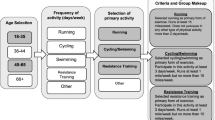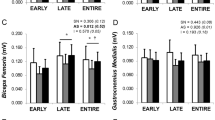Abstract
The goals of the study were to identify adaptational phenomena in running mechanics over a variety of surfaces due to age related changes in the muscle-tendon units (MTUs) capacities, to examine whether running experience is associated with adaptational effects on running mechanics over a variety of surfaces even at old age, and to investigate whether surface condition affects running mechanics. The investigation was executed on 30 old and 19 young including 29 runners and 20 non-active subjects. In a previous study we documented that the older had lower MTUs capacities. In the present study running mechanics were analysed as the same subjects ran at 2.7 m/s over three surfaces having different compliance. Surface condition did not affect centre of mass trajectory, duty factor or joint kinetics (P > 0.01). Older react to the reduced MTUs capacity by increasing duty factor and benefiting from a mechanical advantage for the triceps surae MTU and a lower rate of force generation on all surfaces (P < 0.01). Runners displayed lower average horizontal forces and a higher mechanical advantage for the quadriceps femoris MTU for all surfaces (P < 0.01). The results provided strong evidence on that running strategy remained essentially unchanged over a variety of surfaces. Adaptive improvements in running mechanics due to task experience were present for all surfaces and did not depend on age. We further concluded that older adults were able to recalibrate their running strategy to adjust the task effort to the reduced MTUs capacities in a feedforward control manner for a variety of mechanical environments.





Similar content being viewed by others
References
Aniansson A, Hedberg M, Henning GB, Grimby G (1986) Muscle morphology, enzymatic activity, and muscle strength in elderly men: a follow-up study. Muscle Nerve 9:585–591
Arampatzis A, Brüggemann G-P, Metzler V (1999) The effect of speed on leg stiffness and joint kinetics in human running. J Biomech 32:1349–1353
Biewener AA, Farley CT, Roberts TJ, Temaner M (2004) Muscle mechanical advantage of human walking and running: implications for energy cost. J Appl Physiol 97:2266–2274
Buch ER, Young S, Contreras-Vidal JL (2003) Visuomotor adaptation in normal aging. Learn Mem 10:55–63
Carrier DR, Heglund NC, Earls KD (1994) Variable gearing during locomotion in the human musculoskeletal system. Science 265:651–653
Chang YH, Kram R (1999) Metabolic cost of generating horizontal forces during human running. J Appl Physiol 86:1657–1662
Dempster WT, Gabel WC, Felts WJ (1959) The anthropometry of the manual work space for the seated subject. Am J Phys Anthropol 17:289–317
DeVita P (1994) The selection of standard convention for analyzing gait data based on the analysis of relevant biomechanical factors. J Biomech 27:501–508
DeVita P, Hortobagyi T (2000) Age causes a redistribution of joint torques and powers during gait. J Appl Physiol 88:1804–1811
DeVita P, Blankenship-Hunter P, Skelly WA (1992) Effects of functional knee brace on the biomechanics of running. Med Sci Sports Exerc 24:797–806
Diamond MC, Johnson RE, Protti AM, Ott C, Kajisa L (1985) Plasticity in the 904-day-old male rat cerebral cortex. Exp Neurol 87:309–317
Dixon SJ, Collop AC, Batt ME (2000) Surface effects on ground reaction forces and lower extremity kinematics in running. Med Sci Sports Exerc 32:1919–1926
Erni T, Dietz V (2001) Obstacle avoidance during human walking: learning rate and cross-modal transfer. J Physiol 534:303–312
Farley CT, Houdijk HH, Van Strien C, Louie M (1998) Mechanism of leg stiffness adjustment for hopping on surfaces of different stiffnesses. J Appl Physiol 85:1044–1055
Ferchmin PA, Eterovic VA (1986) Forty minutes of experience increase the weight and RNA content of cerebral cortex in periadolescent rats. Dev Psychobiol 19:511–519
Fernández-Ruiz J, Hall C, Vergara P, Diiaz R (2000) Prism adaptation in normal aging: slower adaptation rate and larger after effect. Cogn Brain Res 9:223–226
Ferris DP, Farley CT (1997) Interaction of leg stiffness and surfaces stiffness during human hopping. J Appl Physiol 82:15–22
Ferris DP, Louie M, Farley CT (1998) Running in the real world: adjusting leg stiffness for different surfaces. Proc Biol Sci 265:989–994
Ferris DP, Liang K, Farley CT (1999) Runners adjust leg stiffness for their first step on a new running surface. J Biomech 32:787–94
Frontera WR, Hughes VA, Lutz KJ, Evans WJ (1991) A cross-sectional study of muscle strength and mass in 45- to 78-yr-old men and women. J Appl Physiol 71:644–650
Gottschall JS, Kram R (2003) Energy cost and muscular activity required for propulsion during walking. J Appl Physiol 94:1766–1772
Herzog W, Read LJ (1993) Lines of action and moment arms of the major force-carrying structures crossing the human knee joint. J Anat 182:213–230
Hof AL (1992) An explicit expression for the moment in multibody systems. J Biomech 25:1209–1211
Hortobagyi T, Mizelle C, Beam S, DeVita P (2003) Old adults perform activities of daily living near their maximal capabilities. J Gerontol 58:M453–M460
Hughes VA, Frontera WR, Wood M, Evans WJ, Dallal GE, Roubenoff R, Fiatarone Singh MA (2001) Longitudinal muscle strength changes in older adults: influence of muscle mass, physical activity, and health. J Gerontol 56:B209–B217
Kagerer FA, Contreras-Vidal JL, Stelmach GE (1997) Adaptation to gradual as compared with sudden visuo-motor distortions. Exp Brain Res 115:557–561
Karamanidis K, Arampatzis A (2006) Mechanical and morphological properties of human quadriceps femoris and triceps surae muscle–tendon unit in relation to aging and running. J Biomech 39:406–417
Karamanidis K, Arampatzis A, Brüggemann G-P (2003) Symmetry and reproducibility of kinematic parameters during various running techniques. Med Sci Sports Exerc 35:1009–1016
Karamanidis K, Arampatzis A, Brüggemann G-P (2004) Reproducibility of electromyography and ground reaction force during various running techniques. Gait Posture 19:115–123
Kerdok AE, Biewener AA, McMahon TA, Weyand PG, Herr HM (2002) Energetics and mechanics of human running on surfaces of different stiffnesses. J Appl Physiol 92:469–478
Kjaer M (2004) Role of extracellular matrix in adaptation of tendon and skeletal muscle to mechanical loading. Physiol Rev 84:694–698
Kram R, Taylor CR (1990) Energetics of running: a new perspective. Nature 346:265–267
Maganaris CN, Baltzopoulos V, Sargeant AJ (1998) Changes in Achilles tendon moment arm from rest to maximum isometric plantarflexion: in vivo observations in man. J Physiol 510:977–985
Marigold DS, Patla AE (2002) Strategies for dynamic stability during locomotion on a slippery surface: effects of prior experience and knowledge. J Neurophysiol 88:339–353
McMahon TA (1985) The role of compliance in mammalian running gaits. J Exp Biol 115:263–282
McNay EC, Willingham DB (1998) Deficit in learning of a motor skill requiring strategy, but not of perceptuomotor recalibration, with aging. Learn Mem 4:411–420
Messier SP, Davis SE, Curl WW, Lowery RB, Pack RJ (1991) Etiologic factors associated with patellofemoral pain in runners. Med Sci Sports Exerc 23:1008–1015
Mulder T, Zijlstra W, Geurts A (2002) Assessment of motor recovery and decline. Gait Posture 16:198–210
Nigg BM, Cole GK, Nachbauer W (1993) Effects of arch height of the foot on angular motion of the lower extremities in running. J Biomech 26:909–916
Nurse MA, Hulliger M, Wakeling JM, Nigg BM, Stefanyshyn DJ (2005) Changing the texture of footwear can alter gait patterns. J Electromyogr Kinesiol 15:496–506
Owings TM, Pavol MJ, Grabiner MD (2001) Mechanisms of failed recovery following postural perturbations on a motorized treadmill mimic those associated with an actual forward trip. Clin Biomech 16:813–819
Pai YC, Wening JD, Runtz EF, Iqbal K, Pavol MJ (2003) Role of feedforward control of movement stability in reducing slip-related balance loss and falls among older adults. J Neurophysiol 90:755–762
Patla AE (1997) Understanding the roles of vision in the control of human locomotion. Gait Posture 5:54–69
Patla AE, Adkin A, Martin C, Holden R, Prentice S (1996) Characteristics of voluntary visual sampling of the environment for safe locomotion over different terrains. Exp Brain Res 112:513–522
Pavol MJ, Runtz EF, Edwards BJ, Pai YC (2002) Age influences the outcome of a slipping perturbation during initial but not repeated exposures. J Gerontol 57:M496–M503
Perry SD, Santos LC, Patla AE (2001) Contribution of vision and cutaneous sensation to the control of centre of mass (COM) during gait termination. Brain Res 913:27–34
Prince F, Corriveau H, Hébert R, Winter DA (1997) Gait in the elderly. Gait Posture 5:128–135
Raz N (ed) (2000) Aging of the brain and its impact on cognitive performance: integration of structural and functional findings. Erlbaum, Hillsdale, NJ
Schultz AB (1992) Mobility impairment in the elderly: challenges for biomechanics research. J Biomech 25:519–528
Shadmehr R (2004) Generalization as a behavioral window to the neural mechanisms of learning internal models. Hum Mov Sci 23:543–568
Sorensen KL, Hollands MA, Patla E (2002) The effects of human ankle muscle vibration on posture and balance during adaptive locomotion. Exp Brain Res 143:24–34
Stelmach GE, Worringham CJ (1985) Sensorimotor deficits related to postural stability. Implications for falling in the elderly. Clin Geriatr Med 3:679–694
van Hedel HJ, Dietz V (2004) The influence of age on learning a locomotor task. Clin Neurophysiol 115:2134–2143
van Hedel HJ, Biedermann M, Erni T, Dietz V (2002) Obstacle avoidance during human walking: transfer of motor skill from one leg to the other. J Physiol 543:709–717
Watanabe I, Okubo J (1981) The role of the plantar mechanoreceptor in equilibrium control. Ann N Y Acad Sci 374:855–864
Winegard KJ, Hicks AL, Sale DG, Vandervoort AA (1996) A 12-year follow-up study of ankle muscle function in older adults. J Gerontol 51:B202–B207
Wolfson L (2001) Gait and balance dysfunction: a model of the interaction of age and disease. Neuroscientist 7:178–183
Wolfson L, Judge J, Whipple R, King M (1995) Strength is a major factor in balance, gait, and the occurrence of falls. J Gerontol 50:64–67
Wolpert DM, Ghahramani Z, Jordan MI (1995) An internal model for sensorimotor integration. Science 269:1880–1882
Woltring HJ (1986) A FORTRAN package for generalized, cross-validatory spline smoothing and differentiation. Advances in Engineering Software 8
Woollacott MH, Shumway-Cook A, Nashner LM (1986) Aging and posture control: changes in sensory organization and muscular coordination. Int J Aging Hum Dev 23:97–114
Acknowledgment
The authors wish to thank G. Morey-Klapsing, S. Stafilidis and G. DeMonte for their help collecting data for this study and for helpful discussions and preparation of the manuscript.
Author information
Authors and Affiliations
Corresponding author
Rights and permissions
About this article
Cite this article
Karamanidis, K., Arampatzis, A. & Brüggemann, GP. Adaptational phenomena and mechanical responses during running: effect of surface, aging and task experience. Eur J Appl Physiol 98, 284–298 (2006). https://doi.org/10.1007/s00421-006-0277-7
Accepted:
Published:
Issue Date:
DOI: https://doi.org/10.1007/s00421-006-0277-7




